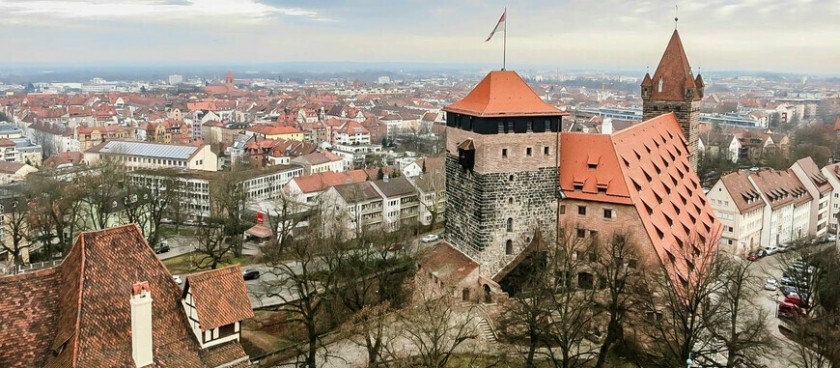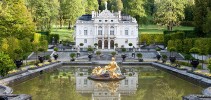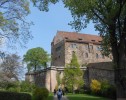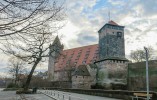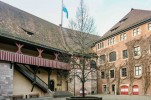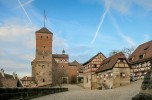- #DE66
- Burg 13, 90403 Nürnberg, Germany
- +499112446590
- burgnuernberg@bsv.bayern.de
- https://www.kaiserburg-nuernberg.de/
- Working hours*:
From April to October 4 - daily 9:00 - 18:00.
From October 5 to March - daily 10:00 - 16:00. - Prices*:
Adult ticket - from 5.50 euro,
Children under 18 years old - free. - * - opening and closing times as well as entrance prices, are subject to alterations without notice. Visitors are advised to check before visiting.
- 49.4579464, 11.0758595 Copy to clipboard Copy
-
#Castles
The Nuremberg Fortress is the hallmark of Nuremberg. The silhouette of the fortress, towering over the city, already in the Middle Ages was a symbol of the power of the Holy Roman Empire and the power of the free city of Nuremberg.
The fortress complex is located in the north of the historic centre of Nuremberg, about 400 meters north of the church of St. Sebald, crowning an imposing rock.
The Nuremberg Fortress is the general name for three defensive structures that were built at different times and for different purposes:
Burggrave's fortress,
Imperial castle.
Burggraf's fortress (Burggrafenburg)
The burgrave's fortress was the first building to appear on the mountain. It is located in the centre of the Nuremberg Castle complex. It is believed that the first castle on this site was erected in 1000 when all the lands in the area belonged to the Raab Dynasty Buhgraf.
Thanks to the successful location of Nuremberg at the intersection of trade routes and the emergence of wealthy merchant classes that regularly pay taxes, Nuremberg managed to obtain from Emperor Frederick II the status of a free imperial city in 1219. The count's fortress on the mountain actively irritated the freedom-loving townspeople, moreover, it interfered with the construction of fortifications around Nuremberg. In the 15th century, the conflict escalated into clashes.
The court flatly refused to give the fortress to the city. In retaliation, the townspeople built such a high tower near Burggrafenburg that from its top they could see everything that happens outside the walls of the fortress. As a result of the Bavarian Wars in the 15th century, the fortress was destroyed and the burgrave ceased to exist. In 1420, the then Count of the Hohenzollern dynasty, Frederick VI, sold to the city what was left of the castle buildings.
Little has survived to this day from the Burggrave's Fortress. The oldest surviving building in the Nuremberg Fortress and the city as a whole is the so-called Pentagonal Tower (Fünfeckturm), built in the 11th century.
Also of interest is the 12th-century St. Walpurga Chapel, where, by the way, Orthodox services are currently held.
Imperial Fortress (Kaiserburg)
The complex of the Nuremberg Imperial Fortress includes several buildings - the Imperial Castle, the Double Chapel, the Round Tower and the Deep Well.
Imperial Castle (Palas)
The first to be built in the Imperial Fortress was the Romanesque Imperial Castle, which has survived to this day, later rebuilt in the Gothic style.
The Imperial Castle is the most famous part of the Nuremberg Fortress complex, where all the emperors of the Holy Roman Empire stayed and imperial conventions were held.
The imperial castle is located in the western part of the fortress. Its construction began in 1140 under Kaiser Conrad III and was completed by Frederick I Barbarossa. The shape of the castle building completely repeats the relief of the rock on which it is installed.
In the Holy Roman Empire, oddly enough, there was no capital. The entire Reich was riddled with a network of small road castles called the Pfalz, about a day's hike away. The emperors were in constant motion, stopping at the sentry, well-protected, fortresses for only a short time.
Nuremberg Castle (Palas) soon became the favourite castle of many generations of emperors. The Reichstags and Imperial conventions were regularly held here, Kaiser Frederick I celebrated his wedding in the castle, and since 1356, according to the adopted law "Golden Bull" ("Goldene Bulle"), each newly elected emperor held his first meeting at Nuremberg Castle. Since 1436, the imperial regalia has been kept in the Nuremberg Fortress.
With the adoption of the Reformation by Nuremberg in 1541, the alienation of the Catholic empire and the evangelical city began. After the Thirty Years' War, the Imperial Conventions were finally moved to Regensburg.
After the collapse of the Holy Roman Empire in 1806 and the annexation of Nuremberg to the Kingdom of Bavaria, the Nuremberg fortress regains a new heyday. Kings Ludwig I, Maximilian II and Ludwig II are engaged in the restoration and reconstruction of the fortress. Since 1858, the royal chambers have been equipped in the Imperial Castle.
How to get there
The Nuremberg Fortress is located in the city centre. It is easy to reach it by any means of transport, as well as on foot.
By public transport
The Nuremberg Fortress can be reached by tram, metro or bus.
By tram (Tram): Line 4, to the Tiergärtnertorplatz stop, then walk 5 minutes.
By underground (U-Bahn): Line U1 to the Lorenzkirche stop or lines U2, U3 to the Wöhrder Wiese stop or U3 to the Nürnberg Friedrich-Ebert-Platz stop, then take bus 36 or walk about 15 minutes.
By bus (Bus): Route 36, N11 to the Burgstraße stop, N10 to the Tiergärtnentor stop, then walk about 6 minutes.
By car
Paid parking is available in the Nuremberg Fortress area.
The nearest:
Fünfeplatz 1, maximum parking time - 2 hours, 2.5 € per hour, to the fortress - 9 minutes on foot,
Maxtorhof, 1-hour parking - 1.20 €, 13 minutes walk to the fortress.
